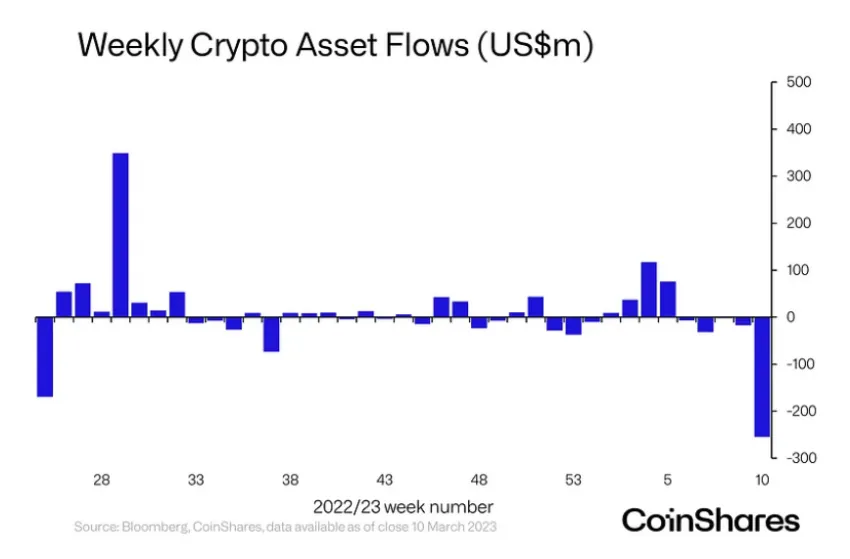Whiplash Hits Crypto Markets Due to Recent Turmoil
The most dramatic week in tech and banking ended with crypto markets rallying on Monday. The wider industry is suffering from a serious case of whiplash.
There’s whiplash, and then there’s whiplash. The industry is holding its head and understandably wondering what has just happened. Just a few days ago, the mood in the industry was panicky. Caused by the news that Silvergate, then Silicon Valley Bank and finally Signature Bank were in crisis.
At the time of writing, the Bitcoin price has pumped 10% on Monday alone, rising 18% to over $24,200 over a 24-hour period. Ether and ADA also saw double-digit increases.
Contagion is avoided, for now
On Sunday, the US government announced a limited aid package. “Depositors will have access to all their money starting Monday, March 13. “No losses related to the dissolution of Silicon Valley Bank will be borne by taxpayers,” they said in a statement.
On Monday, Biden said: “Investors in the banks will not be protected. They deliberately took a risk, and when the risk didn’t pay off, the investors lost their money. That’s how capitalism works.”
The mood in the industry has been generally positive since the announcement. The comments from the US government have had a calming effect.
“Actions taken by the US authorities this weekend seem to be well received by the market as we see strong momentum in crypto today,” said François Cluzeau, Head of Trading and co-founder of Flowdesk, a Paris-based market maker and technology provider. “For now, we seem to be avoiding strong contagion – it seems that the right measures were taken at the right time.”
“Already in recent weeks, liquidity has been affected, uncertainty has caused a significant drop. Today’s significant gains in crypto markets have actually benefited from this. In a low liquidity environment, price swings can be much larger than in periods of high liquidity.”
Cluzeau says many players in the industry were overly dependent on Silvergate and Signature to move their money around. This dependency will make things even more unpredictable. So over the next few days we may see several large price differences between different exchanges.
“On the USDC side, news appears to be positive this morning. Currently trading pretty close to parity with the USD.” The USDC has been depegging in recent days as $3.3 billion of the stablecoin’s reserves remained locked up in Silicon Valley Bank.
Last week saw record exits from stock exchanges
The turmoil caused by the collapse of the tech-oriented banks spooked crypto traders last week.
According to CoinShare’s latest report, released Monday, investors withdrew a record $255 million from exchange-traded crypto funds. This marks the largest weekly outflow the company has ever recorded, reversing the gains in crypto-based funds since the beginning of the year.

The fall in assets under management (AUM) represents a 10% decline in just one week, bringing total AUM to $26 billion. CoinShares tracks the flow of money into and out of various products that track cryptocurrencies. Bitcoin funds were the hardest hit, accounting for $244 million of the money leaving crypto funds.
Other funds, such as Ethereum and altcoins such as Litecoin and Tron, also experienced outflows, but to a lesser extent.
In contrast, Solana, XRP, Polygon and multi-asset funds had a weekly inflow of just $3 million.
CoinShare’s head of research, James Butterfill, noted that while the total weekly outflow was a record, it was not the highest in percentage terms. In May 2019, a weekly outflow of $51 million represented about 2% of all assets invested in crypto funds at the time. Butterfill pointed out that this highlights how much total AUM has increased by a whopping 816% since then.
The underlying confidence in the crypto markets remains strong
Despite spooked traders, and attitudes eroding on Capitol Hill, a recent survey published by Paxos indicates that underlying confidence in the industry is strong.
According to their survey, 75% of consumers remain confident in cryptocurrencies. The survey also found that 72% of respondents were not concerned about market volatility in 2022. In addition, 89% of consumers still rely on intermediaries such as crypto exchanges, mobile payment apps and banks to hold their cryptocurrencies.
The survey was conducted before the recent market turmoil. But the findings indicate that the public’s perception of the cryptocurrency industry is more resistant than expected. While the recent market shock affected the banking sector, the effect on cryptocurrencies was not the primary focus for most people. The cryptocurrency aspect was more of a secondary plot.
Unlike the global coverage of FTX’s collapse last November, this current story is not expected to generate the same level of attention. However, Silvergate’s links to FTX show that the shadow of the stock exchange’s implosion is long.
Crypto remains unbanked for now
While the crypto markets are holding their necks and suffering from a severe case of whiplash, the problems are far from over. The three banks that suffered during the crisis – particularly Silvergate and Signature – played an important role in the US crypto industry. They offered key payment systems that digital asset companies used extensively.
However, these systems may be difficult to replicate now that federal authorities are discouraging banks from working with crypto clients. This means that crypto firms have to find new banks to work with, but few willing partners are available. This mirrors the situation with auditors, many of whom now refuse to work with the industry.
Disclaimer
All information on our website is published in good faith and for general information purposes only. Any action the reader takes on the information contained on our website is strictly at their own risk.


